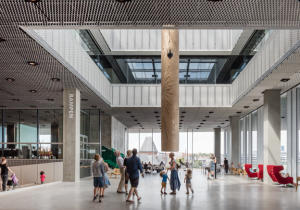
I was initially drawn to the Master of Library and Information Science (MLIS) program due to my love of books and reading, however, I am excited about the MLIS program because libraries are so much more than a place to house books. In INFO 200 Information Communities I was introduced to the Dokk1 public library in Aarhus, Denmark. I was captivated by the space because it functions as a community hub which includes a variety of spaces to facilitate learning, play, social interactions, and serves all the community’s needs. I was especially taken by the bell which sits in the middle of the facility and rings when a child is born at the local hospital. What I have found interesting in my further investigation of libraries as a community space is that the function of a library as a cultural center dates back to the ancient Library of Alexandria and even more recently with the Carnegie libraries of the 1880’s which functioned as “community centers with swimming pools and public baths, bowling alleys, billiard rooms, even rifle ranges, as well as book stacks” (Mattern, 2014). My local library in San Anselmo, California is an Original Carnegie Library which was built in 1915 and is adjacent to our Town Hall and includes the historical museum on the premises. The library itself needs updating with a redesign of the space and I believe that utilizing the Four Space Library Model would be beneficial to creating a more community focused space.
The Four Space Library Model is a way to transform the public library “from a passive collection based space to a more active space for experience and inspiration and a local meeting point” (Laerkes, 2016). The goals of the model include Experience, Involvement, Empowerment, and Innovation and they are achieved through these four overlapping spaces: Inspirational, Learning, Performance, and Meeting (Jochumsen et al., 2012). The spaces are not unique and individual spaces but instead overlap and work together to support the goals of the model. “While the defining characteristics of the first three spaces – inspiration, learning, and meeting – are well known elements of the library experience, the fourth – the performative space – is historically new. The performative space is the place in libraries where citizens are urged to create and perform in their own right – to go beyond being consumers of cultural products in order to become producers of content and co-creators of culture.” (Hapel, 2020). Dokk1 is a gold star example of utilizing the four space library model to design an innovative and engaging community center which provides culture, knowledge, social services, and information to the Aaruhus community.

An important element to transforming the public library into an innovative community hub like Dokk 1 is involving the community in the design process (Leferink, 2018). Collaboration among library staff, administration, government representatives, design professionals, and local community members is critical to creating a successful space (Casey & Savastinuk, 2007). Getting buy in from key stakeholders builds trust and provides a sense of ownership in the project. In the initial planning of Dokk1, they engaged with many different stakeholders through interviews, town hall style discussions, and coffee chats with community members to ensure they had a solid understanding of community needs (Hapel, 2020).
I am inspired by the idea of the public library as a community space and before this assignment I was not aware that this was not a new concept and that it in fact dates all the way back to the ancient library of Alexandria. I am hoping to incorporate some of these ideas regarding design and space into my local library. I strongly believe that it would drive increased usage of library services, garner additional support for library resources, and improve connection within he community.
References
Casey, M.E. & Savastinuk, L.C. (2007). Library 2.0: A guide to participatory service. Information Today, Inc.
Dokk1. (2016, July 11). Dokk1_The_Gong [Photograph]. Flickr. https://www.flickr.com/photos/aakb/29376061104/in/album-72157668074145883/
Hapel, R. (2020). Building a contemporary public library through community engagement: A personal
journey. Public Library Quarterly, 39(5), 391–409. https://doi.org/10.1080/01616846.2020.1772621
Jochumsen, H., Huenegaard Rasmussen, C., & Skot-Hansen, D. (2012, November 16). The four spaces – a new model for the public library. New Library World, 113(11/12), 586-597. https://doi.org/10.1108/03074801211282948
Laerkes, J. G. (2016, March 29). The four spaces of the public library. IFLA Public Libraries Section Blog. https://blogs.ifla.org/public-libraries/2016/03/29/the-four-spaces-of-the-public-library/
Leferink, S. (2018, January 24). To keep people happy… keep some books. OCLC Next. https://blog.oclc.org/next/to-keep-people-happy-keep-some-books/
Mattern, S. (2014, June). Library as infrastructure. Places Journal. https://doi.org/10.22269/140609

Hi Amy,
Thank you for your insightful post! Your post resonated with me, as we both focused on the “four space library model” and involving the community in the design process. I loved reading about how ancient libraries served as cultural centers and had bathhouses, and bowling alleys (and more) .